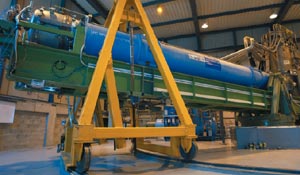The CERN Axion Solar Telescope (CAST) collaboration has released the first results from its search for the solar axion, a viable candidate for a dark-matter particle. The result from CAST’s first year of operation, submitted to Physical Review Letters, does not show evidence for the axion but it narrows down the hunt for this elusive particle.

Axions were theorized more than 25 years ago to explain the absence of charge-parity (CP) symmetry violation in the strong interaction. These neutral, very light particles (in the mass range 10–5 – 10 eV/c2) interact so weakly with ordinary matter that they could have survived until now from their birth at the very beginning of the universe, so could contribute to dark matter. However, axions could also be created today, for example near the strong electric field inside the hot plasma core of the Sun, where thermal X-rays could be efficiently converted into axions. These axions would stream out freely and arrive on Earth in quantities larger than solar neutrinos.
CAST, currently the world’s only working “axion helioscope”, is a prototype superconducting magnet for the Large Hadron Collider that has been refurbished and fitted with X-ray detectors, plus a focusing mirror system for X-rays that was recovered from the German space programme. The 9 T field in the magnet can convert solar axions passing through CAST into X-rays, with the highest efficiency for such a detector to date.
The first results from CAST show that the axion-photon coupling constant is gaγγ< 1.16 x 10–10 GeV–1 for axion masses below 0.02 eV (Zioutas et al. 2004). This new limit is five times smaller than the previous best laboratory measurements, from the Tokyo axion helioscope experiment (Moriyama et al. 1998). However, CAST’s new result is comparable, in the mass range studied, to the best limit derived from stellar energy-loss arguments. It also excludes an important part of the parameter space that is not excluded by solar-age considerations, which allow an axion-photon coupling somewhat larger than the Tokyo limit.
So far CAST has covered the low end of the axion rest-mass range, ma< 0.02 eV/c2. The group is currently remodelling the telescope; filling the two tubes of the magnet with helium gas will keep the X-rays and axions in phase over the magnet’s entire length of 9.26 m. This will allow a search for axions of higher mass, covering more of the range expected from theory and not excluded by astrophysical and cosmological observations.
Further reading
K Zioutas et al. 2004 http://arxiv.org/pdf/hep-ex/0411033.
S Moriyama et al. 1998 Phys. Lett. B434 147.








